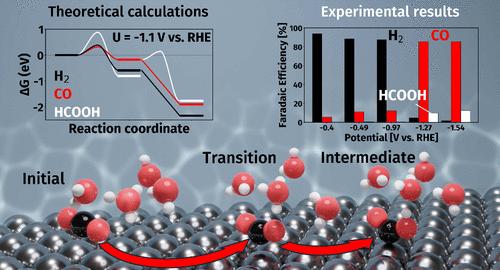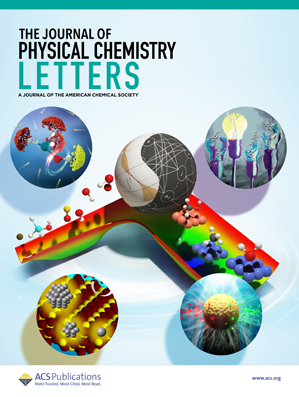银电极在二氧化碳电还原过程中对一氧化碳的高选择性源于电压相关动力学和热力学之间的相互作用
IF 4.6
2区 化学
Q2 CHEMISTRY, PHYSICAL
引用次数: 0
摘要
电化学还原是利用二氧化碳作为原料生成可再生燃料和有价值化学品的一种可行方法。有几种金属可用作生成 CO 和甲酸的电催化剂,但氢的生成是一种不必要的副反应,甚至可能是主要反应。一般来说,缺乏选择性是一个重要问题,但银基电催化剂已被证明具有高度选择性,当应用电压低于 -1 V vs RHE 时,一氧化碳的生产效率超过 90%。在此电压范围内,仅形成少量氢气和甲酸盐。我们介绍了 Ag(111)、Ag(100) 和 Ag(110) 三个低指数面上各种基本步骤的活化自由能随外加电压变化的计算结果,以及多晶电极上的实验测量结果,以找出这种高选择性的原因。由于吸附氢的覆盖率低,且 HCOO* 中间体的形成受到动力学阻碍,因此甲酸的形成受到抑制,即使甲酸的形成在热力学上是有利的;而 CO 形成的关键中间体 *COOH 在热力学上是不稳定的,直到外加电压达到 -1 V vs RHE,此时甲酸的形成动力学比氢更有利。计算结果与酸性条件下进行的实验测量结果一致,并为银基电催化剂的高 CO 选择性提供了原子尺度的见解。本文章由计算机程序翻译,如有差异,请以英文原文为准。

Silver Electrodes Are Highly Selective for CO in CO2 Electroreduction due to Interplay between Voltage Dependent Kinetics and Thermodynamics
Electrochemical reduction is a promising way to make use of CO2 as feedstock for generating renewable fuel and valuable chemicals. Several metals can be used as the electrocatalyst to generate CO and formic acid, but hydrogen formation is an unwanted side reaction that can even be dominant. The lack of selectivity is, in general, a significant problem, but silver-based electrocatalysts have been shown to be highly selective, with faradaic efficiency of CO production exceeding 90%, when the applied voltage is below −1 V vs RHE. In this voltage range, only a small amount of hydrogen and formate is formed. We present calculations of the activation free energy for the various elementary steps as a function of applied voltage at the three low index facets, Ag(111), Ag(100) and Ag(110), as well as experimental measurements on polycrystalline electrodes, to identify the reason for this high selectivity. The formation of formic acid is suppressed, even though it is thermodynamically favored, because of the low coverage of adsorbed hydrogen and kinetic hindrance to the formation of the HCOO* intermediate, while *COOH, a key intermediate in CO formation, is thermodynamically unstable until the applied voltage reaches −1 V vs RHE, at which point the kinetics for its formation are more favorable than for hydrogen. The calculated results are consistent with experimental measurements carried out for acidic conditions and provide an atomic scale insight into the high CO selectivity of silver-based electrocatalysts.
求助全文
通过发布文献求助,成功后即可免费获取论文全文。
去求助
来源期刊

The Journal of Physical Chemistry Letters
CHEMISTRY, PHYSICAL-NANOSCIENCE & NANOTECHNOLOGY
CiteScore
9.60
自引率
7.00%
发文量
1519
审稿时长
1.6 months
期刊介绍:
The Journal of Physical Chemistry (JPC) Letters is devoted to reporting new and original experimental and theoretical basic research of interest to physical chemists, biophysical chemists, chemical physicists, physicists, material scientists, and engineers. An important criterion for acceptance is that the paper reports a significant scientific advance and/or physical insight such that rapid publication is essential. Two issues of JPC Letters are published each month.
 求助内容:
求助内容: 应助结果提醒方式:
应助结果提醒方式:


